Worldwide Survey 2007 on the use of PowerBuilder
As every year, many of you replied
to this large survey on the use of PowerBuilder.
We wish to thank the thousands of participants
for their contribution.
If you have not yet responded to our new survey, now is the time to do it!
Your contribution will be useful to everyone! Take part by completing this form.
As every year, we have done a survey of evolutions
to PowerBuilder projects:
We also analysed the impact of Java / .NET on
PowerBuilder users. Java/JEE technology has been
used widely for many years. Microsoft uses all
its marketing power to impose its platform, rallying
Sybase capability to its cause. PowerBuilder has
thus come closer to .NET technologies in its versions.
- To what extent has Microsoft caught up to Java?
- What proportion of PB teams adopted .NET technology in 2007?
![]() 1.1 Which versions of PB are currently used?
1.1 Which versions of PB are currently used?
![]() 1.2 Types of PB projects in 2007
1.2 Types of PB projects in 2007
![]() 1.3 PowerBuilder and databases
1.3 PowerBuilder and databases
![]() 1.4 New uses for PowerBuilder
1.4 New uses for PowerBuilder
-
PocketBuilder
- Web application development
- Datawindow.NET
- Generation
of .NET code
![]() 1.5 Other technologies used: Java or .NET?
1.5 Other technologies used: Java or .NET?
![]() 1.6 What do you think of PowerBuilder?
1.6 What do you think of PowerBuilder?
![]() Conclusion
Conclusion
1.1 Which versions of PB are currently used?
In 2007, PB10 became the most used version with 38% of projects (PB10 and 10.5 combined), ahead of PB9 (29%) and PB8 (15%).

PB9 has thus come to the end of its lifetime.
PB9 replaced PB8 in 2004 and this year gave way to PB10.
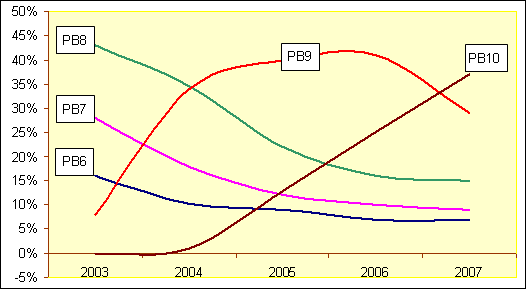
PB11 will show up in the 2008 results, as 45% of projects in 2007
were intending to migrate to a newer version of PowerBuilder.
This percentage is relatively constant: Each year, about half of
PowerBuilder projects intend updating their development environment.
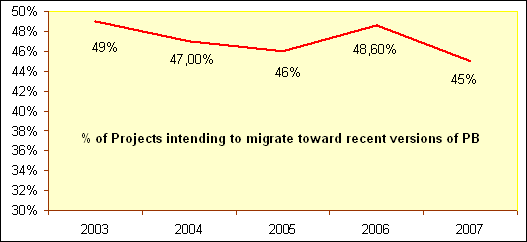
1.2 Types of PB projects in 2007
The size of PowerBuilder projects remains pretty stable from one year to the next:
- 7% of projects are by large teams (more than 20 people). These projects often use PowerBuilder to develop user interfaces and stored procedures for business processing (see questions on databases and development of stored procedures).
- 44% of projects involve 4 to 20 people.
- 48% are managed by small teams (less than 4 people). These are small applications or maintenance-phase applications, taken care of by small teams involving corrections and minor changes.

As PowerBuilder is a mature technology, a large proportion of teams (30%) only manage applications in their maintenance phase:
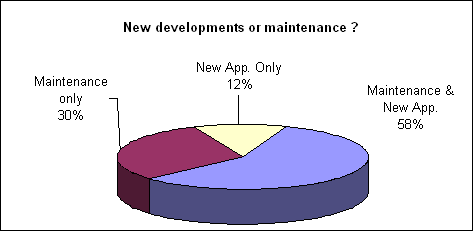
By contrast, 70% of teams develop new applications, of which:
- 58% at the same time manage applications in maintenance phase
- 12% develop only new applications. These new PowerBuilder users
have partly offset the erosion of the PB community.
In fact, although 80% of projects intend to continue using PowerBuilder in the long term for development, 20% said they would soon stop using PowerBuilder.
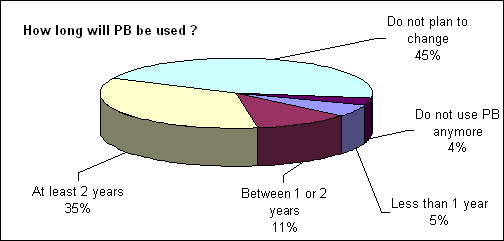
1.3 PowerBuilder and databases
Unsurprisingly, PowerBuilder
projects often use Sybase databases: Nearly half of them use Sybase
Adaptive Server Anywhere (ASA) or Sybase Adaptive Server Enterprise
(ASE).
Databases in Microsoft SQL Server (70% of responses) and Oracle
(58% of responses) are used more.
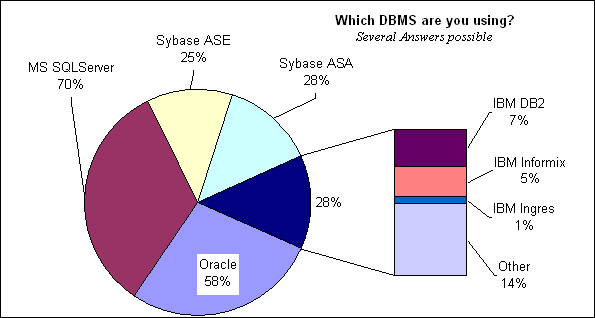
This distribution varies by size project:
- Oracle databases are used more by large teams (74%) than small teams (48%).
- The same is true for databases in Sybase ASE (36% for large projects vs 20% for small), Informix (12% vs 4%) and DB2 (12% vs 7%).
- SQL Server is the most-used database for all projects combined, but it comes second among large teams (74% of large projects use Oracle vs 55% for SQL Server). On the other hand, SQL Server is definitely the favourite in small projects (76% of them use it).

PowerBuilder applications are often associated with database code (triggers, stored procedures, etc). 89% of projects thus develop stored procedures, of which 52% in large quantities:
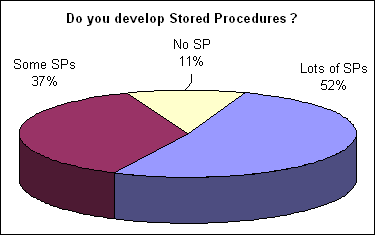
This trend is even more marked in large projects: 95% of them develop
stored procedures, of which 72% in large quantities.
They use PowerBuilder mainly to develop user interfaces, while business
processes are coded on the server.

1.4 New uses for PowerBuilder
PowerBuilder built its
success in the 1990s on the development of client/server applications.
In recent years, Sybase changed its offering to cover new needs
(development of web applications, mobiles, etc).
What success have these technologies had?
PocketBuilder
PocketBuilder has been available for several years for developing
mobile applications. 8% of survey participants said they used
it in 2007 and 21% of them thought they would use it in the future.
In fact, the percentage using PocketBuilder has been oscillating
between 8 and 10% for three years and that figure is unlikely
to change in the future. PowerBuilder has thus been a qualified
success.
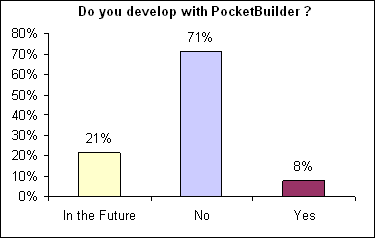
Web application development
In the middle of the 1990s, Sybase launched PowerSite, a web development tool, which was subsequently integrated into PowerBuilder. Sybase then looked to extend PowerBuilder capabilities for web application development.
In 2007, 11% of projects used PowerBuilder for web development:

Datawindow.NET
In the battle between Java and .NET for first place in n-tier development, Sybase went out to support Microsoft technologies.
Sybase thus offered a version of DataWindow for .NET projects.
Like PocketBuilder, 9 to 10% of developers used this component
in the last three years (9% in 2007):
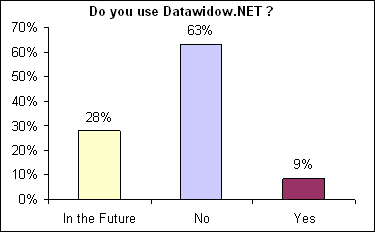
Generation of .NET code
PowerBuilder is now able to generate .NET code from a PB application. 35% of you thought this functionality was strategically important:
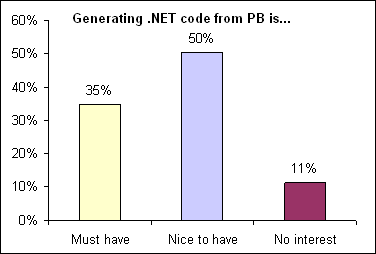
There is clearly greater interest in this than in other recent
PowerBuilder innovations (PocketBuilder, DW.NET, etc). Certainly,
it reflects Microsoft's efforts to see its technology adopted.
Are .NET applications going to become widespread among the PB
community? Will PowerBuilder become an IDE.NET?
1.5 Other technologies used: Java or .NET?
Here we see .NET technologies breaking
through to the top of this class: 48% of PowerBuilder enterprises
also develop Winform and/or Webform applications.
.NET leads Java, although Java still has a respectable following:
38% of PB enterprises also develop Java applications.

This is the first time that Java has lost ground to Microsoft technologies: Usage rates were relatively similar between 2004 and 2006, but the gap widened markedly in 2007 in favour of Microsoft.
Oracle development technologies are staying at 20% usage, but continue to shrink gradually.

1.6 What do you think of PowerBuilder?
The very least we can say is that PowerBuilder users appreciate their development tool! Nearly 40% are extremely satisfied (9 or 10 out of 10) and only 11% scored it less than 7 out of 10. Certainly, these figures do not take into account projects that abandoned PowerBuilder: Generally, developers that move to another technology no longer participate in a PB survey.
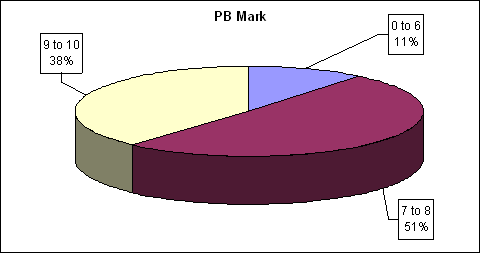
The proportion of very satisfied users (9 or 10 out of 10) has
been higher for the last four years than previously. Over the period
2002-2003 it was in fact nearer 20%.
We can certainly see here the result of Sybase efforts in PowerBuilder
evolution in recent years.
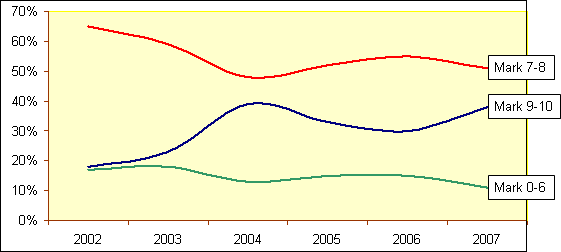
As for the future of PowerBuilder, the main change awaited for PowerBuilder is... better integration with .NET (absolutely vital this year)!
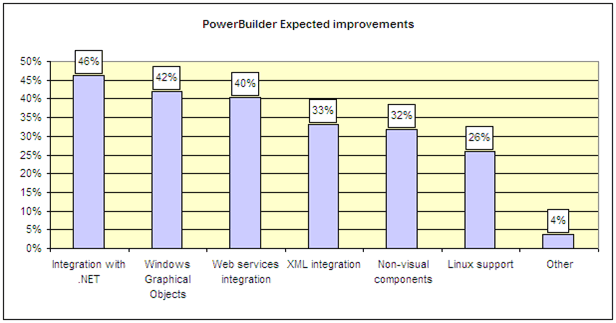
Conclusion
PowerBuilder is a mature
technology, for which many projects are now in maintenance phase.
However, there are as many projects as in previous years and development
teams are just as large. Although the PowerBuilder community is
shrinking, the erosion is barely noticeably in this survey.
Integrating .NET is likely to increase the longevity of the development
and investment carried out using PowerBuilder.
Looking forward, we will be monitoring the adoption of these new
technologies, in terms of types of applications developed, size
of projects, etc.
To participate in our latest survey complete this form.
